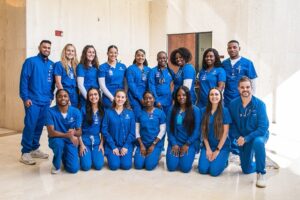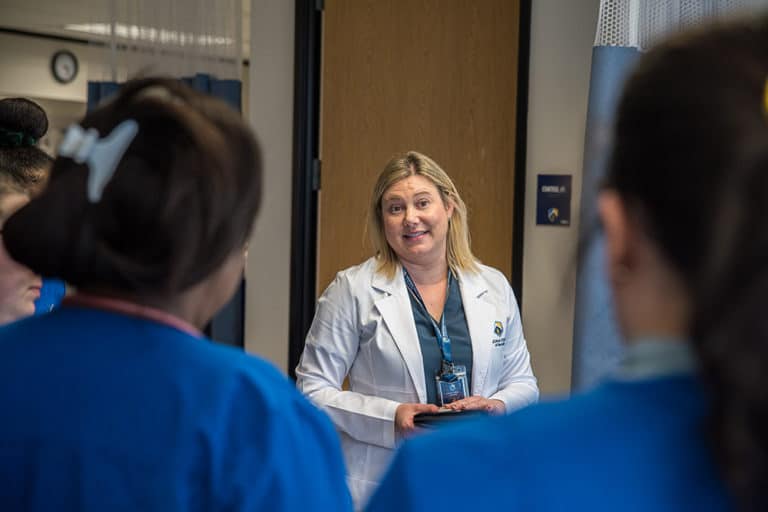Healthcare systems and colleges are working hard to meet the demand for new nurses in Ohio. Arizona College of Nursing recently opened new campuses in Cleveland and Cincinnati. Dr. Suzanne Smith, Dean of Nursing for Arizona College of Nursing’s Cleveland campus shares how the pandemic affected the nursing profession and what needs to be done to rebound.
Lou Whitmire, Mansfield News Journal, January 31, 2023 /—The nationwide nursing shortage is being felt here in Richland County.
“OhioHealth has about 900 open nursing positions, and we have about 90 locally. There is nothing more important at OhioHealth than taking care of our patients, our physicians and nurses and other associates,” OhioHealth spokeswoman Christina Thompson said.
Stephen Wolford, vice president/chief human resource officer, Avita Health System, said, “There is a nursing shortage locally and nationwide which has led to many open positions in all sectors of healthcare, including acute care, long term care and home health.”
Melinda Roepke, dean of Health Sciences at North Central State College, said NCSC has a lot happening to support health care providers in the area including an LPN or licensed practical nursing program which now can be taken evenings.
“Both Avita and OhioHealth are increasingly using LPNs,” she said. All classes for the 30-hour program are held in the evenings May to December.
NCSC spokesman Keith Stoner said the local hospitals are “building the next core of leaders inhouse, encouraging good, young employees to get some training and helping them with tuition reimbursement.”
Bachelor of science degree in nursing at NCSC
NCSC will offer for the first time the bachelor of science in nursing program this fall, to enable nurses to get the degree close to home.
“The talent of our associates is OhioHealth’s greatest asset,” Thompson said. “We are focused on retaining our own great nurses, while bringing in the best and brightest nurses from around the state, and beyond. The dynamic and competitive health care landscape challenges us to be more creative with several incentives to incentivize nurses and pre-licensed clinical extenders (PCEs). PCEs include nursing students or graduates who are awaiting licensure.
“In addition to traditional financial incentives, we offer a number of programs to enhance the nurses’ experience and provide professional growth,” she said. “These include a nurse residency program, medical/surgical registered nurse fellowship program, intermediate and critical care registered nurse fellowship program, patient support assistant fellowship program, programs with local academic partners, internal flex nursing program, and a graduating high school scholar program.”
In addition, six colleges and universities will match OhioHealth’s $5,250 tuition reimbursement amount for little-to-no out-of-pocket cost to full-time associates for certain programs, Thompson said.
Similar to other industries, a nursing shortage was predicted due to the anticipated retirements of experienced nurses, Thompson said.
“Also similar to other industries, the challenge became exacerbated through the pandemic. Some nurses retired early. Some pursued growth opportunities, some wanted employment that offered more flexibility, and others left health care entirely. With all that being said, we are beyond fortunate for those dedicated nurses who chose to stay with OhioHealth and continue to provide bedside care to our community,” she added.
Wolford said Avita Health System offers sign-on bonuses for new hires as well as staff incentives for working additional shifts. “We have competitive benefits, including medical, dental, and vision insurance, as well as generous paid time off,” he said.
Currently, Avita has full and part time RN and LPN openings across the system. Available positions may be found on the Avita Careers web page at avitahealth.org/careers.
Nursing shortage predated COVID pandemic
Wolford said there was already a shortage of nurses pre-COVID.
“During COVID, many nurses across the country retired or left nursing altogether, which further contributed to the current shortage. Additionally, some nurses left their regular jobs and entered into travel nursing assignments,” he said.
There are many reasons for the shortage of nurses, including COVID, said NCSC’s Roepke.
“The last three years were physically and emotionally exhausting,” Roepke said.
Prior to COVID, nurses were aging out of the workforce, but the nursing shortage became worse during the pandemic.
Roepke said the numbers of students in nursing programs nationally are down, and NCSC is seeing fewer students entering the nursing profession.
Stoner said he can’t imagine a hotter job market then in the health sciences.
“Every employer is hungry for qualified professionals,” he said. “Our health sciences graduates are entering careers that are both challenging and rewarding.”
Stoner said the college has a lot of resources to assist students coming back to college, not just financial aid but tutoring and helping them connect to other services they may need, including childcare.
“You’re not a number here. You’re working with people who want you to succeed,” Stoner said.
Dr. Suzanne Smith, DNP, MSN, RN, is dean of nursing for Arizona College of Nursing’s ClevelandCampus.

Smith said in an email answering the News Journal’s questions that the nursing shortage has been an ongoing problem, and the pandemic worsened an already bad situation.
“During the height of the pandemic, there was an increase in patient workload, and nurses saw a significant number of deaths and co-morbidities related to COVID-19. That was a substantial emotional impact; some chose to quit nursing or retire early,” Smith said.
“Education is also an area that has yet to recover. Providing student nurses with clinical opportunities during the pandemic was difficult and sometimes nearly impossible. Patient care was the priority, and rightly so. But that meant some students didn’t progress as quickly in their nursing program,” she added.
Nursing education also was impacted during the pandemic by a move to virtual learning. This change created struggles for students not only academically but financially. Some did not have the resources such as computers, printers, or reliable high-speed internet, she said.
“For parents, homeschooling and childcare was often an obstacle. Some higher educational institutions were not prepared to offer courses online, so nurse educators were forced to recreate the curriculum experience quickly. These factors slowed down the preparedness of new nurses,” Smith said.
Why is there a shortage in Ohio?
“The nursing shortage is not exclusive to Ohio. It is affecting all areas of the country. The American Association of Colleges of Nursing (AACN) anticipates that 1 million nurses will retire by 2030. At the same time, our population is aging and living longer, creating a higher demand for nurses,” Smith said.
“After a period of growth, Ohio has seen a decrease in population and labor force. According tothe state Office of Workforce Transformation, there are nearly 9,000 open positions forregistered nurses,” Smith said.
In addition, nursing school enrollment needs to catch up with the demand for new nurses, evenwith the high interest in the profession. Many qualified applicants are not admitted. Schools like Arizona College of Nursing are helping to fill the gap. Our program is a 3-year BSN program, meaning nurses can join the workforce sooner, Smith said. Smith said health care institutions are thinking outside of the box to recruit nurses because the market is exceedingly competitive. Many hospitals offer sign-on bonuses. Some institutions are also assisting with relocation and tuition reimbursement and are providing incentives to existing employees if they bring in a nurse.
“It’s a great time to be a new graduate. Traditionally, a new nurse had to wait and pay their dues to get their preferred specialty areas and schedule. Many recent graduates are getting multiple offers to work in their preferred area,” Smith said.
“The market is very competitive, and nurses look at more than pay and traditional benefits. Candidates are also considering schedule flexibility, patient-to-nurse ratio, and organizational culture. Nurses want to work for an institution that truly values its employees and believes in delivering safe patient care,” Smith said.


